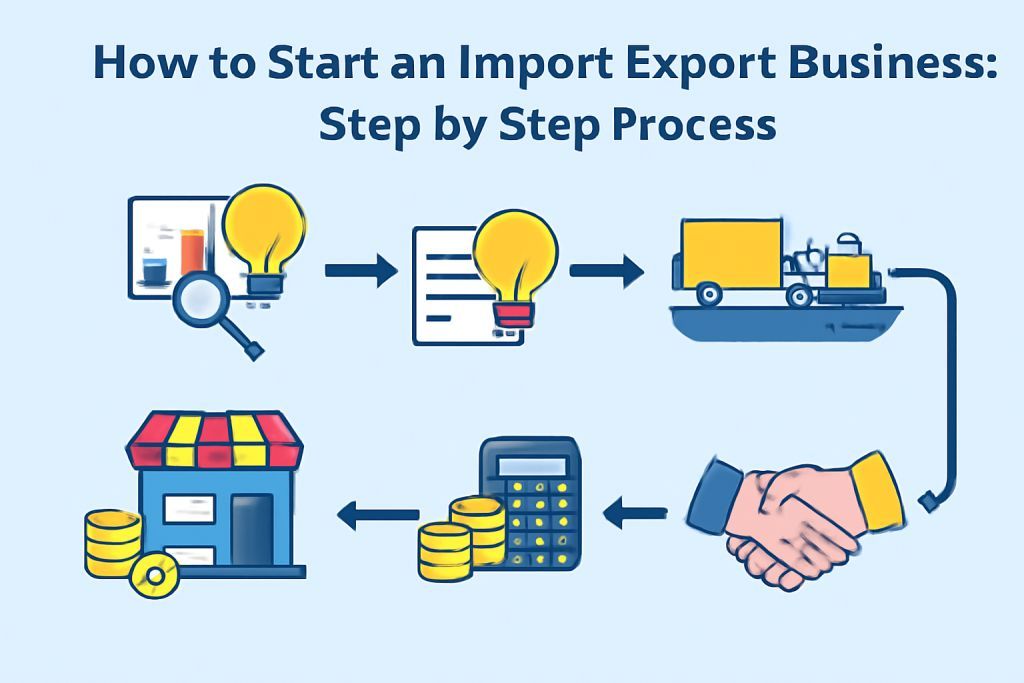
 Thu, 18 Sep 2025
Thu, 18 Sep 2025
How to Start an Import Export Business: Step-by-Step Process
Introduction
Starting an import export business can be an exciting and profitable venture. Global trade has never been more accessible, and with the right planning and resources, you can launch your own import-export company with minimal hassle. In this blog, we’ll guide you step-by-step through the process of starting an import-export business and help you understand what’s required to succeed in international trade.
Whether you’re looking to import products into your country or export goods to new markets, naviexports.com is here to provide you with a roadmap for starting your international business journey.
Step 1: Conduct Market Research
Before diving into any business, especially an import-export venture, market research is crucial. You need to understand the demand for your products, target countries, potential competitors, and the market conditions.
What to Research:
-
Product Demand: Is there demand for the product you plan to import or export?
-
Target Market: Which countries are the best fit for your product?
-
Competition: What are your competitors doing, and how can you offer a unique value?
-
Regulations: Understand the trade regulations in both exporting and importing countries.
You can use tools like trade databases, government export portals, and industry reports to gather this information.
Example: If you’re interested in exporting organic honey, check which countries have high demand for health-conscious food items. You can also evaluate competition and existing trade agreements.
Step 2: Create a Business Plan
Once you’ve done your research, it’s time to create a business plan that outlines your goals, operations, and financial projections.
Your business plan should include:
-
Executive Summary: Brief overview of your business and goals.
-
Business Description: What products will you import or export, and why?
-
Market Analysis: Findings from your market research.
-
Marketing Strategy: How will you attract customers or suppliers?
-
Financial Plan: Outline startup costs, pricing strategies, expected profits, and funding sources.
A solid business plan will help you stay focused, track your progress, and present a professional case if you need investors or loans.
Step 3: Register Your Business and Obtain Licenses
Starting an import-export business requires you to be compliant with local and international laws. Here's what you need to do:
1. Register Your Business
-
Choose your business structure (sole proprietorship, LLC, corporation)
-
Obtain a business license from your local or national authorities.
2. Get an Import Export License
-
Most countries require an Import Export Code (IEC) to engage in international trade.
-
You’ll also need customs registration with your local customs office.
3. Other Permits and Certifications
-
Depending on the type of goods you plan to import or export, you might need special permits (e.g., food safety certifications, health inspections).
For detailed licensing requirements, you can refer to your local trade ministry or customs office.
Step 4: Set Up Your Supply Chain and Logistics
Once you have the legal structure in place, you need to organize the logistics of moving goods across borders.
Key Considerations:
-
Freight Forwarders: Consider hiring experts who can help with transportation and paperwork.
-
Shipping Methods: Decide whether you'll use air, sea, or land shipping, depending on the type and quantity of goods.
-
Incoterms: Learn the international shipping terms like FOB (Free on Board), CIF (Cost, Insurance, and Freight), and DDP (Delivered Duty Paid), as these define the responsibilities of both buyer and seller.
You'll also need to choose reliable customs brokers to handle the paperwork at both ends of the transaction.
Step 5: Build Relationships with Suppliers and Buyers
The success of your import-export business depends on strong relationships with both suppliers and buyers.
How to Find Suppliers and Buyers:
-
Trade Shows: Attend trade fairs and exhibitions to meet potential suppliers and customers.
-
B2B Platforms: Platforms like Alibaba, Global Sources, and TradeKey are excellent for connecting with suppliers.
-
Export Promotion Councils: Join organizations that support international trade to gain credibility and access trade leads.
-
Networking: Build relationships with people in your industry to get the inside track on potential buyers and suppliers.
Step 6: Handle Finances and Payments
International transactions involve foreign currencies and financial risks. Here’s how you can manage payments:
Payment Methods:
-
Letter of Credit (L/C): A safe option where your bank guarantees payment to the seller.
-
Advance Payment: You pay upfront for goods, ensuring that the seller ships the products.
-
Open Account: You receive goods first and pay after delivery, but this can be risky for the seller.
Currency Management: Work with your bank or a foreign exchange expert to mitigate currency exchange risks.
Step 7: Set Up a Marketing and Sales Strategy
Now that your business is operational, it’s time to attract customers and expand your reach. Here’s how you can do it:
-
Create an Online Presence: Build a website, create social media profiles, and use platforms like LinkedIn to connect with global businesses.
-
SEO and Content Marketing: Optimize your website for relevant keywords (like how to start import export business) and write blog posts or articles that answer common trade questions.
-
Export Promotion: Participate in export promotion programs that connect small businesses with international markets.
Step 8: Maintain Compliance and Monitor Your Business
To sustain your business, make sure you stay updated with international trade laws and regulations. Keep accurate records of your transactions, taxes, and financial data to ensure compliance with both local and international laws.
Conclusion
Starting an import export business is a rewarding journey that requires careful planning, research, and perseverance. By following these eight steps, you can confidently enter the world of global trade and create a thriving business.
For more expert guidance on import export business tips, visit naviexports.com, where we share resources and strategies to help you succeed in international trade.





